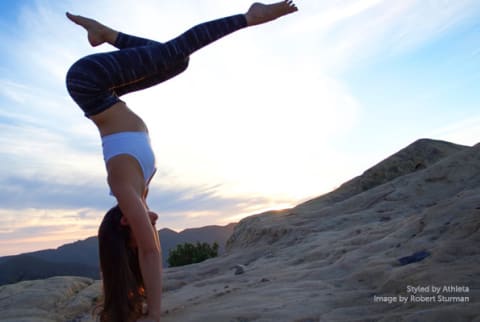Advertisement
5 Steps To Overcoming Your Fear Of Inversions

When it comes to inversions, my yoga class is typically divided into two factions: those who love to invert (or fly, as I like to call it) and those who are petrified of falling. If you are in the second group, yoga can be an intimidating, anxiety-inducing experience as you watch people float effortlessly around you while you struggle to find your wings.
Some degree of fear is healthy. Fear is our body's built-in defense mechanism that keeps us safe from harm. But sometimes fear can become a barrier, preventing us from progressing in our practice and progressing in our lives. Rather than approaching inversions as "advanced" postures for only elite yogis, I like to approach them with a sense of self-inquiry, playfulness and the attitude that anything is possible. Once you break through the barrier of fear, inversions become a powerful tool for teaching us how to breathe, cultivate balance and find strength when our world feels flipped upside down.
Here are five simple ways to push past fear and learn how to soar:
1. Break inversions into smaller steps.
Breaking down each inversion into smaller, more approachable pieces builds strength and confidence. Every yoga pose is comprised of elements of other basic poses. For example, Handstand is simply Mountain Pose (Tadasana) flipped upside down. To move toward Handstand, you need to build a strong foundation upright. Once you've mastered proper alignment in Mountain Pose, incorporate poses like Downward Dog (Adho Mukha Svanasana), Plank Pose and Side Plank (Vasisthasana) to develop the shoulder girdle and core strength required for Handstand. Once you can hold Downward Dog, Plank Pose and Side Plank comfortably for 5 to 10 breaths, you are ready to begin exploring the world upside down.
2. Have an exit strategy.
The law of gravity states that what goes up must come down. Unfortunately, most new yogis are so focused on going up that they forget all about coming down — and the return to earth is where most injuries occur. Having a solid exit strategy makes inverting safer and much less scary.
There are many ways to fall out of a handstand, and some are better than others depending on the individual and the setting. One of the most popular ways to come out of Handstand is to fall into a backbend. This method is perfectly fine if you can perform Upward Bow or Wheel Pose (Urdhva Dhanurasana) with control and ease, but many of us don't have the flexibility in our shoulder girdle and upper back to support falling into a backbend without risk to the shoulder joints and lower back. If Upward Bow is not a strong, regular pose in your practice, it's best to avoid it as fall-out strategy.
The second option is the tuck-and-roll method. This method works well on forgiving surfaces (like a padded spring floor in gymnastics class), but it's not ideal in a crowded yoga room with hardwood floors. Save this option for gymnastics and ninja training only.
The third option (and my personal preference) is to execute a controlled cartwheel out to the side. Cartwheeling teaches us how to deal with momentum and allows us to control our bodies in motion when we kick up with a little too much zest. Channel your inner child and take your cartwheel practice to the park. Infusing your practice with playfulness takes the pressure off the pose and allows you to explore the infinite possibilities of your body with child-like wonder.
3. Take your practice away from the wall.
While this flies in the face of conventional yoga wisdom, I've found the wall is often the biggest hindrance to a handstand practice. More often than not, students use the wall as a crutch and practice against it for years without gaining the confidence to move to the center of the room. When I learned to handstand as a little girl in gymnastics, the wall was never an option. Looking back, this was one of the biggest blessings because it taught me to trust in my own strength and ability. Once you've built up the strength and learned how to properly fall, you are ready to fly away from the wall.
4. Think outside of your mat.
Leave your mat behind and take your inversions outside of the studio. Find a forgiving surface that feels less intimidating than the hardwood floors and slippery sweat puddles of most yoga studios. One of my favorite places to practice handstand is outdoors in a big grassy park.
5. Practice with patience.
Inversions don't happen overnight. They require a lot of patience, practice and perseverance. Repetition is the key to mastery. Be kind to yourself and know that falling is a part of the journey. Our falls make taking flight that much sweeter.
Photo courtesy of the author
